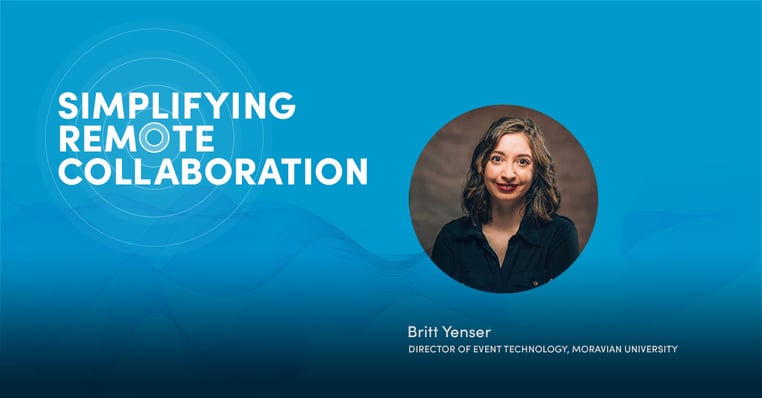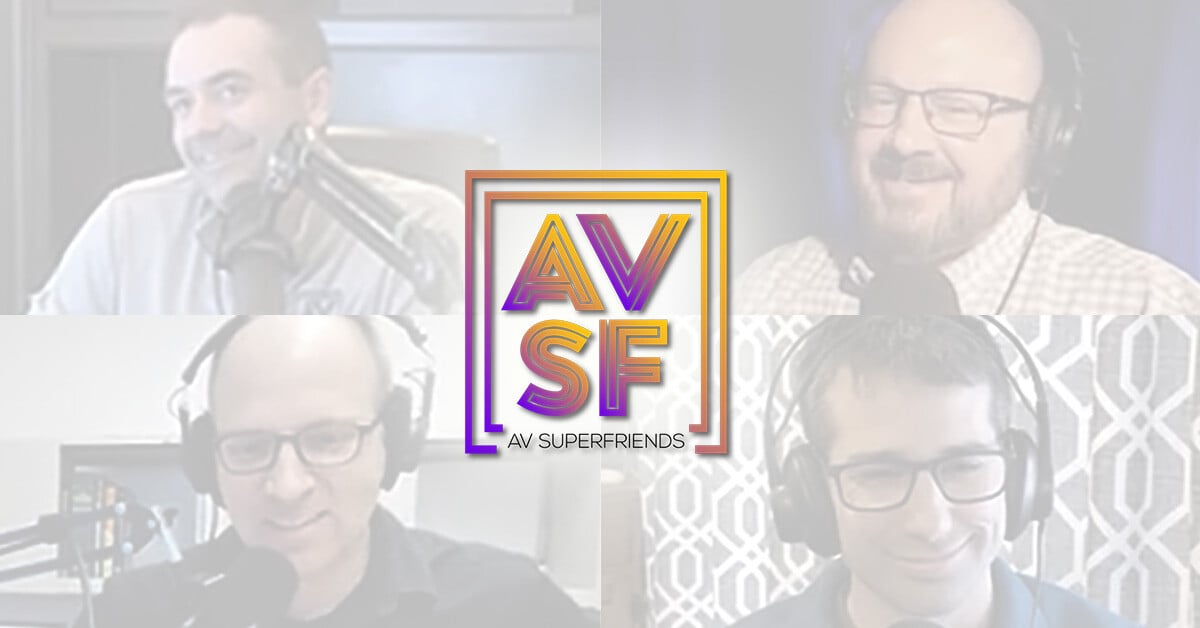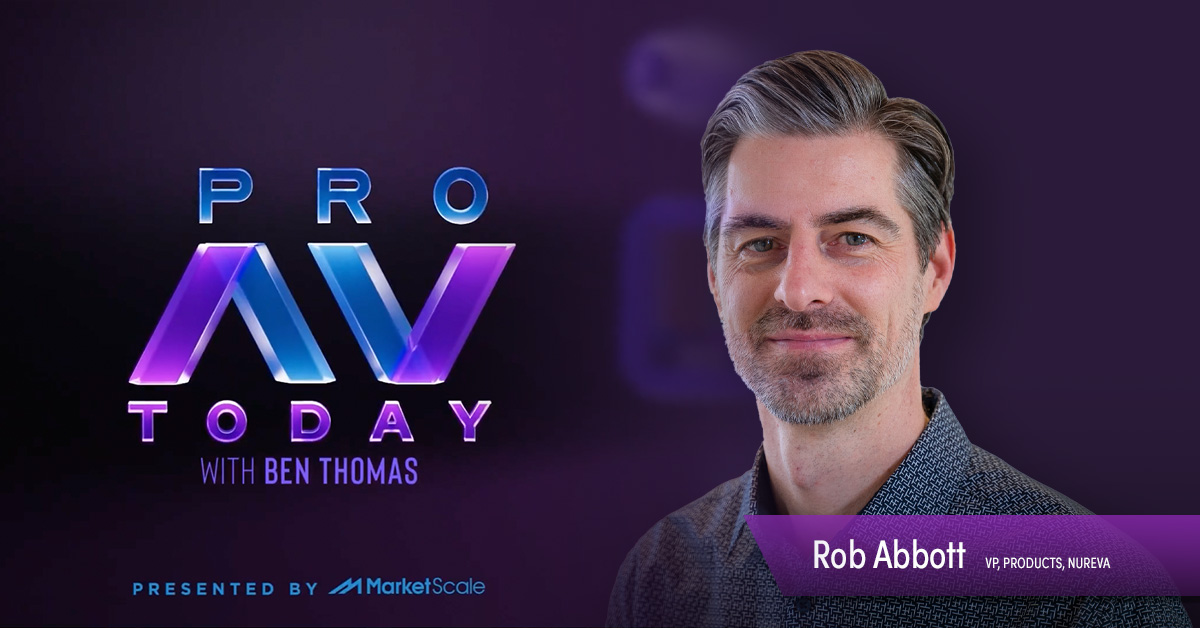Video podcast: Higher ed AV tips from veteran tech director

Posted by Dave McKean on Sep 21, 2023 6:00:00 AM
The COVID-19 pandemic and the rise of hybrid work and HyFlex learning have fundamentally changed what it means to work in IT. In this episode of the Simplifying Remote Collaboration podcast, Ben Thomas talks to Britt Yenser, director of event technology at Moravian University. Britt has insights on working with decision makers, the primacy of shared goals, dealing with feedback, the rewards of working in higher ed AV and much more.
Time stamps
2:15 – Rising above faculty conflict
4:11 – Contributing to education goals
6:09 – Closing the communications loop
8:06 – Simplifying technology solutions
9:41 – Knowing your shared mission
11:43 – Metabolizing feedback
13:58 – Translating needs into technology
16:17 – Moving to a software-based world
17:53 – Getting into higher ed tech
Podcast transcription
Series introduction: Welcome to Simplifying Remote Collaboration. In each episode, we’ll discuss how the shift to hybrid working and learning has put growing pressure on IT departments to better support remote collaboration. At a time when resources are stretched thin by competing priorities, we’ll explore ways to simplify the IT setup and management of hybrid spaces.
Ben Thomas: Hey everyone, and welcome back to Simplifying Remote Collaboration. I’m your host for today, Ben Thomas. As our AV community continues to expand to newer and even in some cases non-traditional verticals, it has really changed some of the ways that we do business, not only from a channel perspective, but a project management perspective. Also, increasingly, from a stakeholder perspective. And what has happened is that as we have increased the number of stakeholders through different communities, there tends to be a knowledge gap between the technology implementation and execution side and some of those higher-level conversations, whether it be with executive boards or vice presidents … people like that.
And, and one of the places that you see that a lot is in higher education. Whether it’s making sure that we’re creating workflows or enterprise spaces that can accomplish the goals of our educational institutions or hit learning objectives or achieve things like DEI. Now the technology world has really come in and helped empower a lot of that. So, I wanted to bring on somebody today who could really help bridge that gap and give us some practical advice and tips on some of the ways we could bridge the gap between the executive decision-making community and a lot of those technical installers and the technical decision-making community as well. And that’s Britt Yenser, director of event technology over at Moravian University. Britt, thanks so much for coming on the show today.
Britt: Hi. Thanks for having me.
Ben: It’s easy for me to come in and say that the channel has evolved, but you’re someone who lives it every single day. Even in a post-COVID world, things have just changed at such a rapid pace. In your perspective, how are some of the ways that you’ve seen those extra voices coming in and what are some of the challenges that you’ve seen pop up?
Rising above faculty conflict
Britt: I would say – and it’s something that I’d say often – that hybrid or HyFlex was always coming, but the pandemic accelerated it. That is the largest change and it has led to the conflicting voices that we’re hearing in higher ed, because you have faculty who are invested in HyFlex and there are faculty who want things to revert back to all in-person learning – how things used to be. Unfortunately for the people who want that, it does not seem to be what the reality is going to be. So, there’s the conflict.
Ben: Well, it’s interesting, you talk about HyFlex – that’s kind of the perfect example. For a long time, higher-level remote or non-traditional learning tools were kind of pie in the sky. You know, it’d be nice to have some online tools, things like that. But then overnight we had to make a pretty significant pivot. And you talked about some of those people on both sides really having to battle with that. But one of the challenges was that while it’s cool to have an idea and say that you want to run with it, it’s totally different for the technology side having to actually execute on that. What are some of the challenges and even conflicts that popped up just from a communication standpoint?
Britt: Well, it was obviously the supply chain, because people didn’t necessarily understand that immediately. They started to understand it when it hit them at the consumer level. But when it first started to happen, it was unclear to some people why it was difficult to get the technology that we needed to implement. And honestly, just communicating the amount of time and amount of labor that the upgrades require – sometimes people don’t really understand that. You know, when technology works well, you don’t really notice. And so, I don’t think that people necessarily realize how much work is happening on the backend to make these things happen.
Contributing to education goals
Ben: You bring up a great point about whether it’s an actual function of technology or whether it’s aligning with a vision. A lot of times, especially now, I would say the initiation of the project looks a little bit different. Whereas, in the past it might have been a little bit more project-based or individual school-based, now a lot of times, whether it’s HyFlex learning or whether it’s larger initiatives that come from a little bit higher, there’s almost a little bit more insulation between the technology implementation team and that executive team. But one of the things you talk about online is making sure we’re achieving learning objectives or learning goals or serving the larger mission of the education community. How does the technology team loop in some of those higher-level decision makers to actually make sure that not only are we building an incredible tech stack, but we are actually achieving a lot of these goals.
Britt: We’re fortunate at my university that we have a VP that represents the IT department. So our area is already represented at that table. We can tell our VP what our needs are and then he can translate that. I do find it’s helpful, even when working with our VP, to communicate in less technical ways so that he knows exactly how we need it explained. It’s kind of like two conversations at once. You can talk the talk with him and tell him all of the specs and the nitty gritty, and then also translate it and say like, “this is how I need it packaged,” when you take it to the table.
Ben: You talked a little bit about the chain of command that you have from an event side. But if you would break it down just a little bit deeper, how typically do you see projects come down from an ideation standpoint to a budgeting to an execution standpoint? What does that look like for you?
Closing the communications loop
Britt: So, I would describe that as being almost circular until it reaches a completion. You have the people at the top who say, “we have this vision,” and then it comes down to us and we determine how we feel that vision should be executed. And it goes back to them and they say, “yes, no, maybe,” – you know. They send their questions back to us. It’s kind of this constant communications loop until ultimately what we as the boots on the ground say we feel is the best solution at the best price is normally ultimately what they accept at the top.
Ben: On the ideation, budgeting and pre-execution side, what are some of the differences and challenges that you’re seeing pop up? Obviously, we’d be living in an ideal world where we got an exact budget and exact outcomes. But the reality is that’s not always the case. What does that process and project management process look like and how has it changed?
Britt: I would say it’s definitely challenging. A lot of institutions right now are experiencing budget cuts and needing to tighten the belt, so to speak. For me, it really comes down to being creative with things. What do I already have at my disposal that I might be able to use in a different or unique way? Maybe this was not its intended purpose. Meeting Owls are a great example of that. Their intended purpose is to sit in a conference room. But if you need to Zoom in a performance hall that has absolutely nothing in it, then maybe I’m just going drop in this Owl because it’s going to do what you need it to do. So, getting creative with your limited resources.
Simplifying technology solutions
Ben: The point that you bring up is simplicity. I think, as a technology world – I hate to say this, but it’s our reality – at times we overcomplicate things, we like to be the person who knows how to fix things. Whether it’s with the Meeting Owl or an all-in-one solution or even something that’s just very, very simple like an iPad or whatever. Talk about how the role of simplicity has actually helped bridge that gap a little bit. Because even some of the technical challenges that may have existed before, whether it be signal flow, whether it be hardware, some of those might not actually exist because we’re looking at simplifying some of these solutions. Talk about that a little bit.
Britt: Yeah, I would say it’s definitely budget friendly. It’s definitely helpful if you’re like me and you rely a lot on student employees in higher ed. The simpler a solution you can come up with so that it’s easy for a student technician to implement, that will make everyone’s lives more successful.
Ben: That’s exactly right. And that’s really the role of that insulator – that person who can communicate a lot of those things. And it’s interesting to look at how it’s happening in education, but it’s happening in enterprise spaces. There isn’t that middleman a lot of the time, right? There might not be an integrator for a lot of these projects because the channel looks a little bit different. There might not always be that insulator between the subject matter expert and that higher-level decision-making staff. What do you recommend and what are some of the things that you’ve seen be effective for those who may not have that insulator?
Knowing your shared mission
Britt: I would say, especially in the higher education vertical, it’s important that all departments are aligned with the university’s or college’s mission in some way. I think that you should be able to stop any employee on a campus and ask them what their mission statement is for the university, and they should be able to tell you. You are all, at the end of the day, on one team with one primary goal for your institution, and then just finding ways to align your particular work with the larger work of your institution. When you have that in mind and you’re able to see this is the large mission, this is how I fit into it, and how my work fits into it, that makes that conversation much easier.
Ben: Let’s stick on that student-facing side a little bit. One of the, the major goals of a higher education institution, or any educational institution for that matter, is to achieve learning outcomes – to successfully communicate and teach students at their best level. I want to ask about that feedback loop. At the end of the day, as much as we, we want to pretend we’ve always got our finger on the pulse of everything, how do we act as that feedback loop? Maybe to help connect the dots between some of those students who may or may not be enjoying specific technologies and some of that upper-level management style?
Britt: That’s a good question. Are you thinking more of the academic side or the social side?
Ben: If I’m a student who’s leveraging a new piece of technology, whether it’s bring your own device, whether it’s a setup in a meeting room … so more on the student and academic side. Sourcing feedback obviously is a massive part of that – to help achieve those learning outcomes. How do you help bridge the gap as somebody who’s regularly involved in those technology decisions between the student and the user and that upper-level side.
Metabolizing feedback
Britt: We gather feedback as we can. And a lot of the feedback, I would honestly say, comes more from the faculty than the students. We are an Apple distinguished school, so all our students have their MacBooks and iPads, and they’re comfortable with being a primarily Apple product campus. We have Apple TVs all over the place, which is really more of a consumer-level device, so that makes it difficult to manage on our end, but easy for the students to use.
We don’t get many complaints or concerns on the student end. But any feedback that we do get, we kind of metabolize it and figure out what is really worth taking up the chain. Like, is this a true issue? Does this really need to be fixed? Because that’s important. You have to determine what is at the core of this feedback. Is it that the technology is not user-friendly and they need training? Or it’s not user-friendly and just throw it away and try again to make it easier? And if we’re throwing it away, well now we need money and resources and we have to take that up the chain. So, we’re just trying to figure out what exactly is needed to fix a given issue.
Ben: It’s funny you bring that up. I’ll get a chuckle from the hardware community in AV, but it’s funny how we do have a tendency to overcomplicate things and make things work how we would prefer them to work. But sometimes it’s as simple as putting in Apple TV or putting an all-in-one speaker/soundbar/microphone in the room that really can take it to the next level. Right? And when you think about not only the learning objectives but maybe some of the challenges such as accessibility, ADA compliance or aligning with the DEI initiatives of the university – things like that – how do you help represent that from a technology side? Because we’re often the ones who have the most knowledge about specific products, specific workflows, things like that. How do you help act as a liaison between that?
Translating needs into technology
Britt: Yeah, so in my particular role as director of event technology, I often am actively interfacing with various groups across campus. Anyone who is looking to host an event and have it supplemented with AV, then I’m in that conversation from the ground floor to discuss what it is they’re looking to do. So, it becomes a constant translation of “you want to show something on a screen,” okay, now I translate that to “there’s projection in that space, or that should be a TV, or what is it?” It’s often just getting to understand what it is people want to accomplish and then translating that to the technology that they need. And oftentimes I don’t share that translation with them. I keep things very non-technical, like, oh, you want to show something? You want to play music, you want to show a video? You want people who are online to talk back at you? Okay, got it. You don’t need to know all the pieces and parts I’m putting in to make that happen.
Ben: That’s a great point. I think that going along with our tendency to overcomplicate things, we have a tendency to say, oh, well this has to go into this and this feed has to go back into this. And then we’ve got to run a mic. At the end of the day, we’re there to help serve our end-user community. And, and I love hearing your perspective. Whether it’s using consumer devices, whether it’s keeping some of the high-level stuff away from end users. I love hearing about that execution style. As somebody who obviously has been in higher ed for a while, I love to hear that and see how that vision of serving your communities, whether it’s serving students or the faculty, I love to see that vision you’re focused so heavily on. I’ll wrap it up with this question: What are some of the things that you would like to see in the next generation of technology where we’re looking at an evolving channel? Would you like to see more involvement from hardware partners? Would you like to see more training materials? Would you like to see maybe more training, even on the technology side, on how to help best communicate some of these best practices? What are some of the things that you would ideally love to see?
Moving to a software-based world
Britt: I do think that in a lot of ways we are moving away from hardware and more into a software-based world, especially given how much students enjoy being online and having virtual experiences. So, I would actually like to see more user-friendly software and better training experiences. Because there are some major software and videoconferencing companies whose products do not immediately feel user-friendly, especially as you’re reading their directions. There are certain platforms we’ve gotten very used to and we just assume everyone knows how to do that. But those same platforms are constantly undergoing updates and the documentation on their websites are not always clear. I would just like that world to get a little bit smoother, because I do think that students prefer that world.
Ben: Well, I couldn’t agree with you more and, and I love really breaking down some of these discussions with you. I’ll ask this final question: As we continue to bring people into our little community of AV tweeps and AV people just in general, as we expand as a group of technology … I hate to say the word “nerds,” it’s killing me not to say the word “nerds,” but we’re just technology-minded folks. You know, as we continue to expand, what’s some advice you have for those people who may be wanting to get into academia and higher education and really elevate their technical skills to help teach and educate and train.
Getting into higher ed tech
Britt: I think it really depends on the person. I’m a person who learns by doing. So, my immediate advice is just go do it. Just jump in and give it a try, because that’s how I learn. I don’t think I really understand something fully until I get my hands on it. To be authentic to how I learned, my advice is to just give it a try. Especially if you already have a different AV background. If you understand the tech and you just want to break into higher ed, you have the knowledge base already there. So just give it a try and give it a try with an open heart. Higher ed is a very special vertical. We’re doing more than just providing pieces and parts. We’re contributing to people’s education. We’re contributing to people’s social experience. A lot of people have very fond memories and experiences from their college experience, and that’s something that you’d be contributing to. So, you have to put some heart into it as well.
Ben: Well, Britt, we appreciate you coming on the show today. Hope to have you on again soon. It’s been so great to have you on and looking forward to hearing more from you in the future.
Britt: All right. Thanks so much for having me.

Posted by
Dave McKean
September 21, 2023

















